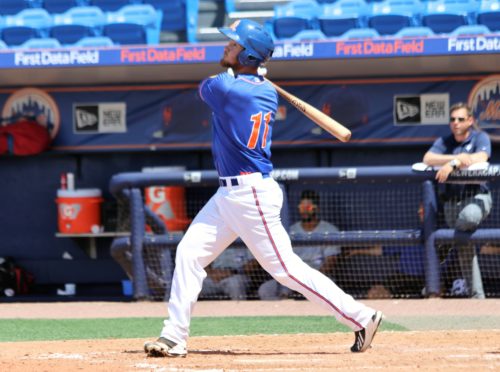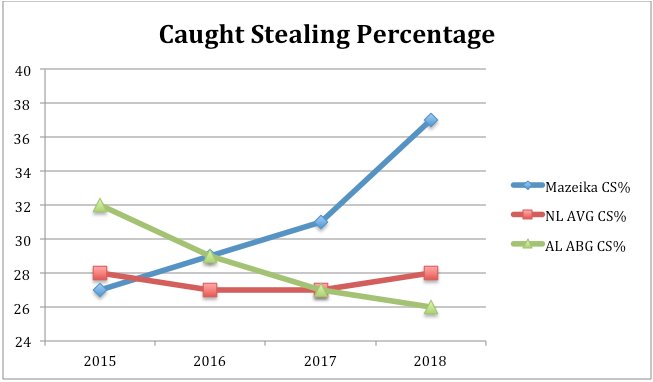
When it comes to position player prospects, what position would Mets fans want that considering the Major League product? If your answer were catcher, then I’d have to agree with you. This week, I want to take a look at a prospect that is perhaps a bit overlooked. That prospect is last week’s MLB Pipeline Catcher of the Week: Patrick Mazeika.
To brief everyone on Mazeika, he’s a product of Stetson University (also the alma matter of one Jacob deGrom), and was drafted in the eighth round of the 2015 draft (239th overall), in a draft where he was fairly overlooked as well. Even as a college product, Mazeika was known for having an advanced approach at the plate, getting on base often, and striking out at a low clip.
| Mazeika NCAA | BB % | K% |
| 2013 | 12.26 | 7.28 |
| 2014 | 13.13 | 6.95 |
| 2015 | 12.94 | 6.27 |
What Mazeika lacked was power. Throughout his three years at Stetson, he held an ISO of .113 in 2013, .117 in 2014, and .178 in 2015. Despite his ISO being so much higher in 2015, he only hit one more extra-base hit than in his previous year – 21 to 20 – but hit seven home runs compared to just two a year prior.
The Mets were pretty conservative in their handling of Mazeika upon his being drafted in 2015 as he started with the Kingsport Mets (rookie ball), and hit .354/.451/.540, with a .451 wOBA, and a 176 wRC+.
The following two seasons, his peripherals held at approximately the same rates, but his power went down significantly, and he held an ISO of .096 in Columbia, and .119 in St. Lucie in 2017. He did ISO .238 last year in Binghamton, but that was over the course of just six games, and Mazeika running into a string of doubles is no rare thing.
Oddly enough, the power has held in 2018. Going into Thurday’s matchup against Bowie, Mazeika holds a .182 ISO. He’s hit six homeruns in just 139 plate appearances, whereas he only hit seven in 414 plate appearances just a year ago. All of this at no expense to his approach at the plate as his walk rate is still at 9.7 percent, and his strikeout rate is still at 12.9 percent.
Let’s get one thing straight before moving forward, Mazeika is not a power hitter. His motion in his swing is very “flat.” Now what I mean by that is that his body stays fairly straight throughout his swing. He does not generate much hip motion in his swing, and he isn’t producing power from his back leg.
At 6’ 3”, 208 pounds, he’s not a small guy, and that weight is definitely going somewhere. What Mazeika does have is respectably strong hands, which helps him generate hard contact, and gap power. Every once in a while, some of those line drives go over the fence. Well, this season, it seems Mazeika may be tweaking his launch angle, and more of those line drives are going over the fence, as indicated by a 46.1 percent fly ball rate.
Mazeika’s season numbers are currently at .223/.317/.405, with a .330 wOBA, and a 104 wRC+. Now those are respectable numbers overall, but the average is not his mean. Well, his BABIP is currently sitting at .214. While Mazeika is making as much contact as ever, he’s hit some hard luck. Since May 14, Mazeika is hitting just .154/.179/.192, but his BABIP is .182 in that time. Prior, Mazeika was hitting .242/.361/.463, despite a .224 BABIP, and a solid 11.7 percent strikeout rate. That’s good for a .370 wOBA and 131 wRC+.
There’s definitely reason to believe he’ll return to his mean, and that all his hits won’t simply go into gloves as he continues to maintain high contact rates, and low strikeout numbers.

Unmistakably, Mazeika was drafted as a bat-first catcher. There have been many questions about whether or not he can stay at catcher. Thankfully, he spent most of last year under the watch of St. Lucie manager Chad Kreuter, who spent the better part of 16 seasons at backstop in the Major Leagues, and was known for being an excellent defender.
There is word that Mazeika’s defense did come along a bit last year, but he’s still working showing that he can stay at catcher long-term. He’s struggled early on a bit this year with three passed balls in 228.2 innings, but he’s also working with pitchers with better stuff, so an adjustment period is likely necessary.
Mazeika does have decent pop time. Now, I don’t have the data for this right now, as this information isn’t readily available for the minor leagues, but he’s reasonably quick in his motion from home to second. Having just an average to slightly-above-average arm, Mazeika has thrown out 13 of 35 (37.0 percent) potential base-stealers this year, and has seen improvements every season since he was drafted.
Every player has their strengths and weaknesses, and Mazeika is no different. We’ve seen where he excels, as well as what needs improvement, and where he’s already improved. In my humble opinion, Patrick Mazeika is a guy you should watch for.

